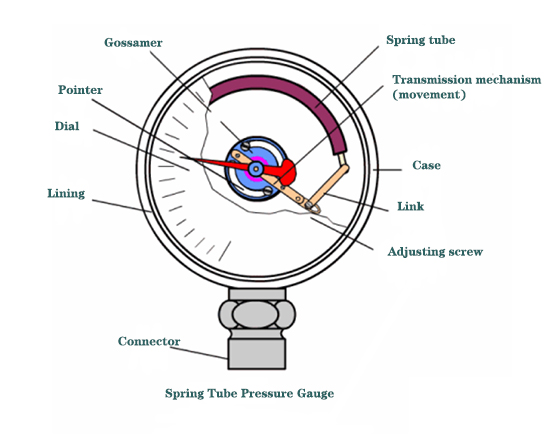What is Pressure Gauge used for?
In the 21st century and even in the future, it is an inevitable trend for enterprises to implement advanced automation, and instruments and meters will be indispensable for the operation of equipment. Pressure gauges refer to instruments that use elastic components as sensitive components to measure and indicate pressure higher than the environment. Since the main body is mostly made of stainless steel and has strong sealing performance, it has strong corrosion resistance, which undoubtedly expands the scope of use in the industrial field. Therefore, it is essential to understand the specific application range of the pressure gauge. Today let's learn the application and structural knowledge of pressure gauges.
Pressure gauges show the difference in pressure between two given points, usually expressed in DP; this is an important pressure reading in almost all industrial process systems. As long as a small pressure difference may have a major impact, such as monitoring the pressure drop of filters, filters, separators, valves, pumps, displaying the liquid level in the tank, detecting system leaks, measuring liquid flow, etc. It is necessary to measure the pressure difference few.
Application
Applications for pressure gauges include clean rooms, heat exchangers, refineries, petrochemical plants, chemical plants, and power plants. Maintenance is performed at any given time on a particular duct or duct carrying airflow. Therefore, by monitoring the differential pressure, you can know the effectiveness of the product in use, so as to ensure that the product is safe and works under standard conditions.
1. Pressure gauge for filter application
The most popular application for pressure gauges is filter monitoring. When the filter element begins to become clogged with contaminants, the pressure between the inlet and outlet increases and efficiency decreases. When the differential pressure reaches a certain limit, the operator knows it is time to replace the filter, keeping the process running smoothly and efficiently and preventing damage to the system. Likewise, pressure gauges can be used to detect scale buildup in pipes and pumps.
2. Monitor the flow rate of the liquid
Pressure gauges are an inexpensive and simple alternative to the large and expensive flow meters used to measure the flow of media in pipes. A pressure gauge (Such as 200 psi pressure gauge) can be attached to measure the pressure difference across the orifice to determine flow. The high-voltage port is connected on the input side, and the low-voltage port is connected on the output side.
3. Tank level measurement and cryogenic applications
In an open tank, the high pressure port of the DP gauge is connected to the bottom of the tank and the low pressure leg is vented to atmosphere. The DP gauge indicates the height of the liquid in the tank. By connecting the high pressure side to the low pressure side of the bottom, this measures the difference between the gas pressure and the total pressure, giving very accurate level readings for tanks measuring liquid oxygen, nitrogen and similar cryogenic media. This can be a very cost effective solution.
4. Use a DP meter to detect accumulation
By monitoring pressure changes in filters, valves or machinery, DP gauges can indicate any sediment buildup in the system. This contributes to the smooth operation of the system and promotes optimal operation of the system.
5. Use a DP meter to detect leaks
It can be determined whether a leak is occurring in the DP between the potentially leaking container and the reference container. This saves time and provides accurate measurements during long waits for pressure to drop in standard pressure gauges (Such as 160psi pressure gauge).
Structure
Overflow hole: In the event of an emergency where the Bourdon tube bursts, the internal pressure will be released to the outside through the overflow hole to prevent the glass panel from bursting. In order to maintain the normal performance of the overflow hole, it is necessary to leave a space of at least 10mm behind the watch, and the overflow hole cannot be modified or plugged.
Pointers: In addition to standard pointers, other pointers are optional.
Glass panel: In addition to standard glass, other special material glass, such as tempered glass, non-reflective glass is also optional.
Performance classification: ordinary type (standard), ordinary type for steam (M), heat-resistant type (H), vibration-resistant type (V), vibration-resistant type for steam (MV), heat-resistant and vibration-resistant type (HV).
Treatment: Oil Free/Water Free Treatment Residual water or oil is removed during manufacture.
Designation of exterior decoration: In addition to the standard color, the color of the shell needs to be specially specified.
Throttle valve (optional): In order to reduce pulsating pressure, a throttle valve is installed at the pressure inlet.
How to increase the service life of the pressure gauge
It is best to install a buffer gauge bend during the use of the pressure gauge, which can provide a buffer protection for the pressure gauge. Most of the damage to the pressure gauge is due to instantaneous impact damage.
The range of the pressure gauge should match, which can not only measure correctly but also protect the pressure gauge from being damaged. Pressure gauges are divided into medical food grade and ordinary grade. Special attention is that 316L sanitary grade stainless steel pressure gauges must be used in the medical, food, and pharmaceutical industries.
Pressure gauges should be calibrated regularly, damaged pressure gauges should be replaced in time, and potential safety hazards should be eliminated in time.


